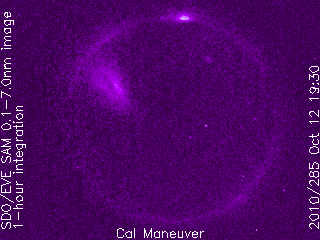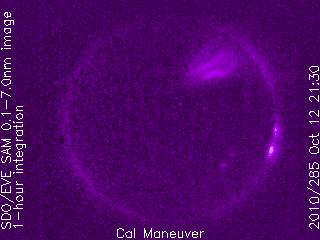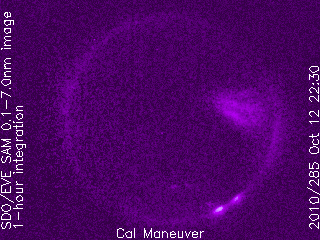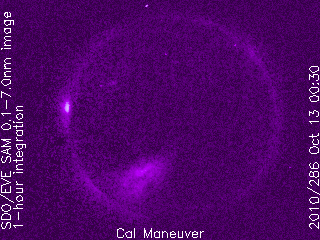It looks like you're using an Ad Blocker.
Please white-list or disable AboveTopSecret.com in your ad-blocking tool.
Thank you.
Some features of ATS will be disabled while you continue to use an ad-blocker.
share:
Whatever it is, i found it interesting that when the sunspot closest to it rotated under it, the spot flared dramatically and actually seemed to
illuminate the object in question!
Theses kept me bugging all day, now i'm home from work and i can finally leave my 2 cents here.
Okay guys, i'm scared. Let me explain why:
-NASA's press conference is today.
-some weird black "object" is near the sun.
-NASA discovered a black hole in our 'neighbourhood" (that's a vague discription, it could be anywhere)
-the object is not affected by gravity and light
-notice the flares that go crazy when crossing the object
Conclusion:
We're screwed, it's a black hole!
Black holes are not affected by gravity and stars (like our sun) are their birthplaces.
I really, really hope i'm wrong, but if you connect the dots there is no other option at all.
Only good thing is: It's a really slow process, the world won't end tomorrow but in 1000 years or so.
Okay guys, i'm scared. Let me explain why:
-NASA's press conference is today.
-some weird black "object" is near the sun.
-NASA discovered a black hole in our 'neighbourhood" (that's a vague discription, it could be anywhere)
-the object is not affected by gravity and light
-notice the flares that go crazy when crossing the object
Conclusion:
We're screwed, it's a black hole!
Black holes are not affected by gravity and stars (like our sun) are their birthplaces.
I really, really hope i'm wrong, but if you connect the dots there is no other option at all.
Only good thing is: It's a really slow process, the world won't end tomorrow but in 1000 years or so.
reply to post by ahumanbeing
I bet if it were a black hole, NASA would make efforts to send cameras into the black hole and see what happens lol. But since our planet's destruction wouldn't be for another 1,000 years I think we've got plenty of time to high-tail it out of here.
I bet if it were a black hole, NASA would make efforts to send cameras into the black hole and see what happens lol. But since our planet's destruction wouldn't be for another 1,000 years I think we've got plenty of time to high-tail it out of here.
edit on 11/15/2010 by Ihsahn because: grammar
reply to post by ahumanbeing
don't fret, you are wrong. there is no black hole adjacent to our sun that
just got discovered.
I would worry about microsingularities coming out of ATLAS/CERN uncontained.
Also worry more about a large object like the much talked about planet X.
don't fret, you are wrong. there is no black hole adjacent to our sun that
just got discovered.
I would worry about microsingularities coming out of ATLAS/CERN uncontained.
Also worry more about a large object like the much talked about planet X.
Are there any images from the L2 orbit that can either verify or disprove this earth-sized object?
I think the “dirty lens” deduction is kinda easy.
I think the “dirty lens” deduction is kinda easy.
The Nasa Conference is about a nearby Black Hole.. discovered by Chandra.
But obviously not close enough to give us worry.
Nearby being relative.
But obviously not close enough to give us worry.
Nearby being relative.
edit on 15-11-2010 by nuke_c because: (no reason given)
Just a little dirt in the optics or damage to the sensor array. The object appears a little too fixed. If the same object is exactly there next week
we'll know.
I will agree with the flaw in the imagery hypothesis but if you would like a another potential explanation I can toss one out.
It could be Venus, which would complete roughly 1/10th of it's solar orbit during this ~27 day observation. While the effect would be very small due to the SDO/EVE's distance from the Sun, the movement of the satellite might be enough to place Venus into a retrograde motion relative to the observer which could potentially give the appearance of the object being stationary. It does seem to progress towards the camera during the recording, to me anyhow.
As the planet rounds the sun there would be a point in time when it appears to come towards the Earth (if the planetary alignment was correct at the time) and in conjunction with the apparent retrograde motion produced by the motion of the camera you might see it as relatively motionless.
I didn't go into detail on the metrics to confirm this, as I think it is most likely a camera issue.
It could be Venus, which would complete roughly 1/10th of it's solar orbit during this ~27 day observation. While the effect would be very small due to the SDO/EVE's distance from the Sun, the movement of the satellite might be enough to place Venus into a retrograde motion relative to the observer which could potentially give the appearance of the object being stationary. It does seem to progress towards the camera during the recording, to me anyhow.
As the planet rounds the sun there would be a point in time when it appears to come towards the Earth (if the planetary alignment was correct at the time) and in conjunction with the apparent retrograde motion produced by the motion of the camera you might see it as relatively motionless.
I didn't go into detail on the metrics to confirm this, as I think it is most likely a camera issue.
Originally posted by ahumanbeing
Okay guys, i'm scared. Let me explain why:
-NASA's press conference is today.
-some weird black "object" is near the sun.
-NASA discovered a black hole in our 'neighbourhood" (that's a vague discription, it could be anywhere)
-the object is not affected by gravity and light
-notice the flares that go crazy when crossing the object
Conclusion:
We're screwed, it's a black hole!
They found a young black hole or wind nebula in the constellation Virgo.
Pretty far away.
Originally posted by etcorngods
reply to post by AgentSmith
The Object also stays in the same relative position to the SUN -- and to Space.
Woah there! Just put down the finger cymbals a minute and try and concentrate. I'll show you frame by frame:
Does it still look like the 'object' is in the same position relative to the sun when the sensor reorientates? No, of course it doesn't, it's in the same position relative to the frame and that's because it's an artifact in the imaging system.
Another point worth noting is that the time frame of the video is over weeks, the artifact has been present since the beginning and will be there until the instrument fails.
The entire archive is here:
lasp.colorado.edu...
reply to post by ahumanbeing
No don't worry my friend! It's definately not a black hole and there definately is no black hole anywhere near our solar system
When we talk about our cosmic 'neighbourhood' the distances involved are usually still vast.
In the case of the black hole in question, it is actually in another galaxy to ours and approximately 50,000,000 light years away. It's special because it is so young, or to be specific the data gathered from it is. The data being gathered is from only 30 years after it's creation, though because it is 5*10^7 light years away it is actually that amount in years older than we perceive it obviously! Definately nothing to worry about, the supermassive blackhole in our own galaxy is a lot nearer and I suspect there are other normal blackholes that are too A black hole will not completely 'suck in' everything either, which is a common misconception. It is only after you go past the event horizon which is based at the schwarzschild radius of the original star then there is no escape even for light. Objects such as planets can quite happily orbit a blackhole as they would a star, which most people don't even realise.
edit on 15-11-2010 by AgentSmith because: Spelling
edit on 15-11-2010 by
AgentSmith because: (no reason given)
I always thought the Sun would burn anything up that was that close.
Boy was I wrong or aliens are so advance that I don't want them coming here
and dominating us.
Boy was I wrong or aliens are so advance that I don't want them coming here
and dominating us.
its dirt on the lense a few posts back some one debunked it noticing the black spot doesnt fade out when the sun does...
i hope someday people wil start reading atleast some potsts in thread before posting
i hope someday people wil start reading atleast some potsts in thread before posting
This is one of those days when nothing seems to be going right! I've mislaid my reading glasses, and for the past almost 10 minutes have been
studying a speck on my computer screen!
I have to agree with the opinion that there is some speck on the camera. I should imagine even if it were some object it is obviously burnt to a
crisp, ha ha.
Peace,
Seq
Peace,
Seq
reply to post by Terviseks
OK I don't know waht it is either. But I know it's not a mother ship. If it were a mother ship stuck in the sun's corona then THAT ship would have to be hundreds of times bigger that planet Earth. SO...It's not a mother ship. I say dead pixels or something way closer that originaly thought.
OK I don't know waht it is either. But I know it's not a mother ship. If it were a mother ship stuck in the sun's corona then THAT ship would have to be hundreds of times bigger that planet Earth. SO...It's not a mother ship. I say dead pixels or something way closer that originaly thought.
What the f is that !?! Is it a spot erased from the vid to hide something "they" don't want us to see ?
maybe its planet x. a giant star thats gonna smash into the earth. if that picture is for real than its about to hit the fan soon.
new topics
-
Feng Shui…
Health & Wellness: 3 hours ago -
Elon Musk to Make Games Great Again - XAI_GAMES Announcement Incoming.
Video Games: 5 hours ago -
North Korea in Ukraine conflict???
World War Three: 5 hours ago -
Most Complex Backyard Rube Goldberg Machine You'll See All Day
General Chit Chat: 6 hours ago
top topics
-
Most Complex Backyard Rube Goldberg Machine You'll See All Day
General Chit Chat: 6 hours ago, 7 flags -
North Korea in Ukraine conflict???
World War Three: 5 hours ago, 5 flags -
Feng Shui…
Health & Wellness: 3 hours ago, 5 flags -
Elon Musk to Make Games Great Again - XAI_GAMES Announcement Incoming.
Video Games: 5 hours ago, 4 flags
active topics
-
Feng Shui…
Health & Wellness • 8 • : JJproductions -
Elon Musk to Make Games Great Again - XAI_GAMES Announcement Incoming.
Video Games • 6 • : Athetos -
North Korea in Ukraine conflict???
World War Three • 15 • : KnowItAllKnowNothin -
-@TH3WH17ERABB17- -Q- ---TIME TO SHOW THE WORLD--- -Part- --44--
Dissecting Disinformation • 3423 • : angelchemuel -
Post A Funny (T&C Friendly) Pic Part IV: The LOL awakens!
General Chit Chat • 7852 • : KrustyKrab -
Encouraging News Media to be MAGA-PAF Should Be a Top Priority for Trump Admin 2025-2029.
Education and Media • 84 • : WeMustCare -
Chasing Red Mercury – One Drop from Doomsday?
General Conspiracies • 57 • : Coelacanth55 -
I thought Trump was the existential threat?
World War Three • 141 • : WeMustCare -
Most Complex Backyard Rube Goldberg Machine You'll See All Day
General Chit Chat • 6 • : angelchemuel -
Ben Habib has Left Reform UK
Regional Politics • 9 • : angelchemuel














